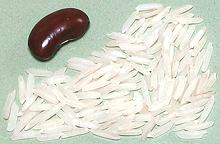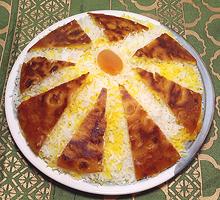
[Polo (Farsi); var. Domsiah (black end), Binam, Hasani, Salari, Ambarboo, Sang Tarom, Hasan Sarai; Doodi (smoked rice); Oryza sativa Basmati type]
Domsiah is the most prestigious of the Iranian rice varieties. It is a highly aromatic very long grain basmati type rice with a rather low yield (less than 1/2 a high yield rice). It's also vulnerable to stem borer insects, fungus, and has harvesting problems (weak stem). The other varieties listed above are similar and have similar problems but together account for 80% of Iranian production due to customer preference. Development of high yield varieties continues but so far has failed to maintain the aromatic qualities of the genuine article. Iranian rice is not exported to the U.S.A. due to political reasons, and that the Iranians have none to spare.
Note that many Iranians prefer "Persian" in regard to culture, cuisine, and history, "Iran" in regard to the country, government and national matters. Persia was the Greek name for the region, and quite close to the name of one of the major imperial cultures there.
The photo to the left is of a woman harvesting rice in the Sangar District in the far north of Iran. Photo by Fars News Agency distributed under license Creative Commons Attribution-ShareAlike v4.0 International.
More on Rice.
 Iranians in North America cannot get Iranian rice, so they use a good Indian
Aged Basmati, though they consider Indian rice inferior to real Iranian rice.
Royal, India Gate, Dunar, Tilda, and Farmer's Club are popular brands.
Iranians use no other type of rice in Iran, but Iranians in North America
may use Thai Jasmine for a few selected dishes - it is much shorter and a
bit stickier.
Iranians in North America cannot get Iranian rice, so they use a good Indian
Aged Basmati, though they consider Indian rice inferior to real Iranian rice.
Royal, India Gate, Dunar, Tilda, and Farmer's Club are popular brands.
Iranians use no other type of rice in Iran, but Iranians in North America
may use Thai Jasmine for a few selected dishes - it is much shorter and a
bit stickier.
 Rice came rather late to Iran. The first mention of it in text is from
about the 7th century and only along the Caspian seacoast. Bread was the
staple for the rest of Iran. Rice as a staple started to spread to the
rest of Iran in the 13th century and by the end of the 16th century it had
become a major part of cooking throughout the country.
Rice came rather late to Iran. The first mention of it in text is from
about the 7th century and only along the Caspian seacoast. Bread was the
staple for the rest of Iran. Rice as a staple started to spread to the
rest of Iran in the 13th century and by the end of the 16th century it had
become a major part of cooking throughout the country.
Almost all Iranian rice is still grown along the coast of the Caspian
Sea, where it was being grown in the 7th century. Despite it's late
appearance, Iran developed a method of cooking very different from how
rice is prepared by its neighbors. Only in Gilan, along part of the Caspian
coast, is our familiar absorption form of rice cooking traditional.
Chelo ba Tahdig is the "official" Persian Rice. It is made in steps: washing, soaking, boiling, and then steaming, always with a crispy crust called Tahdig (lit. "bottom of the pot"). It's on the bottom, which becomes the top when the rice is turned out. For details see our recipe Persian Rice. Today, it is also made in a single pass in special rice cookers that produces a crispy bottom.
Kateh is rice cooked by the familiar absorbtion method. Originating from Gilan on the Caspian coast, it has spread to other parts of Iran as an "everyday rice" recipe. It is often served plain with plain yogurt to sooth the digestive system.
Dami is just like Kateh, except that grains or beans are steamed along with the rice. They should be well soaked before mixing with the rice.